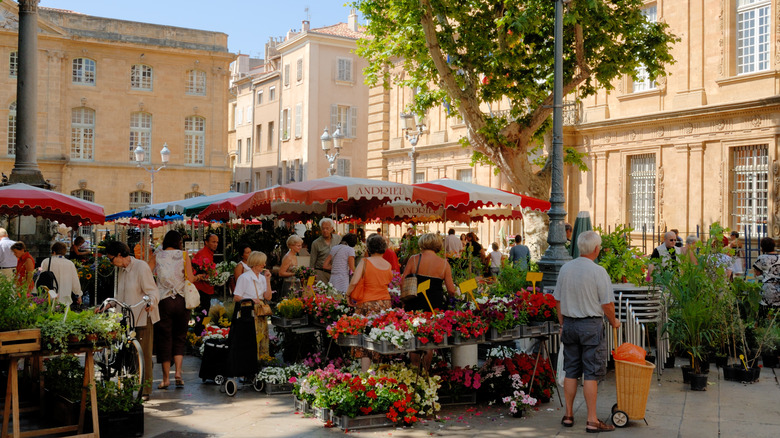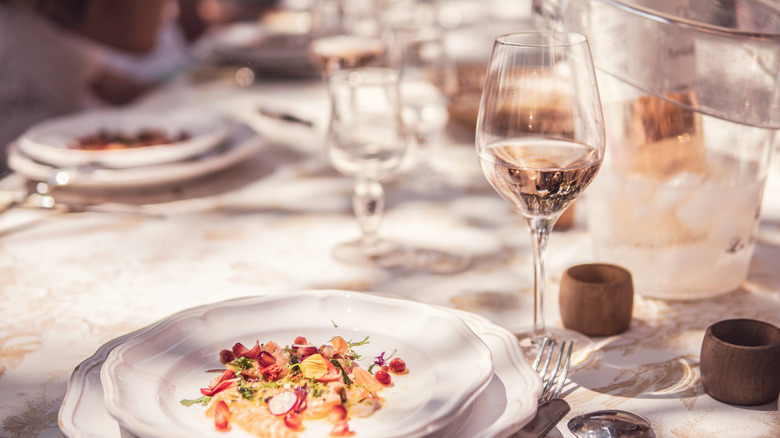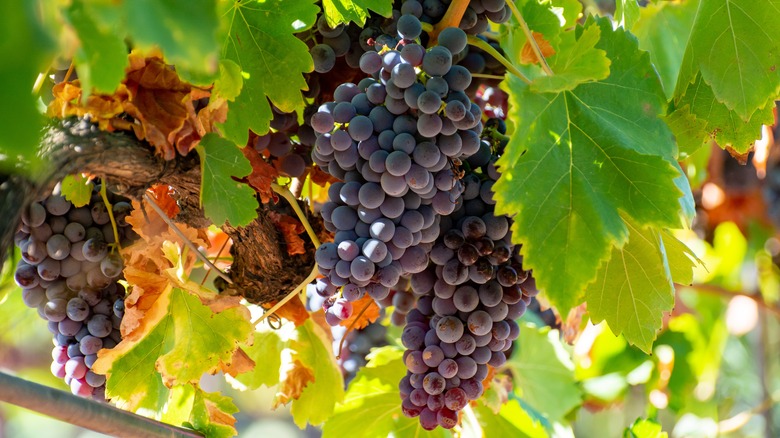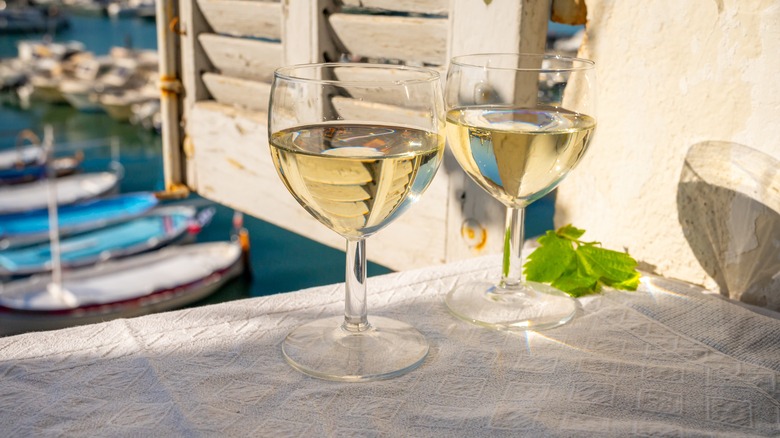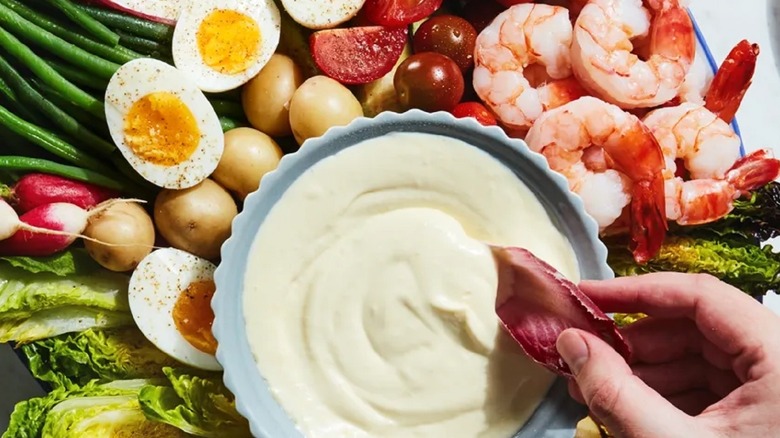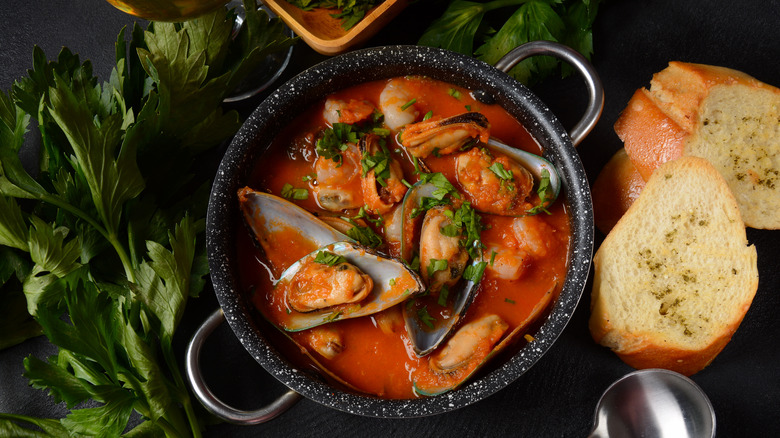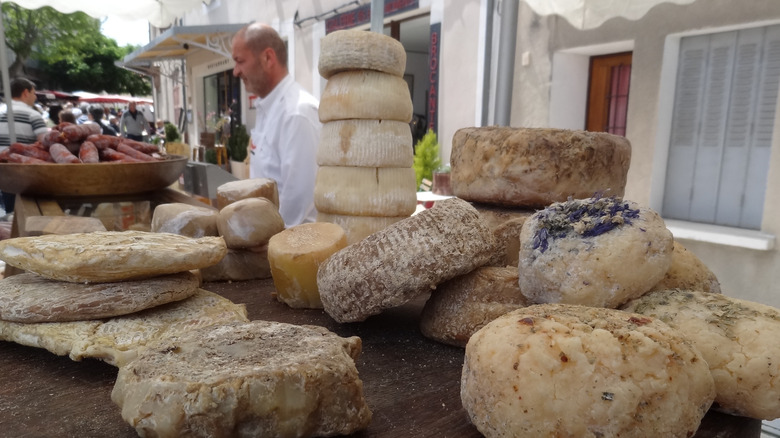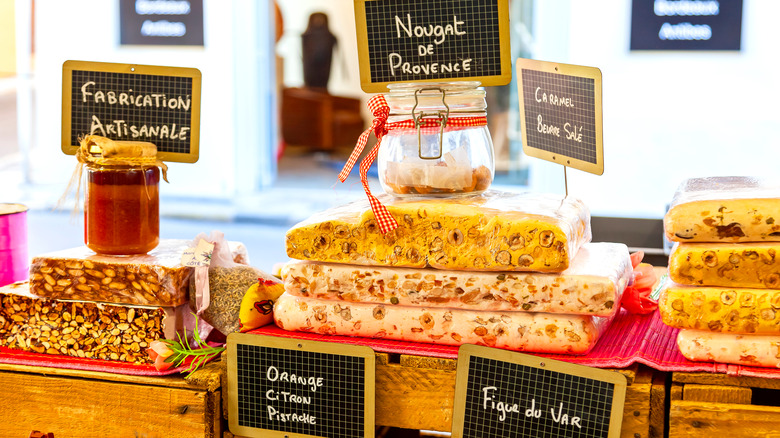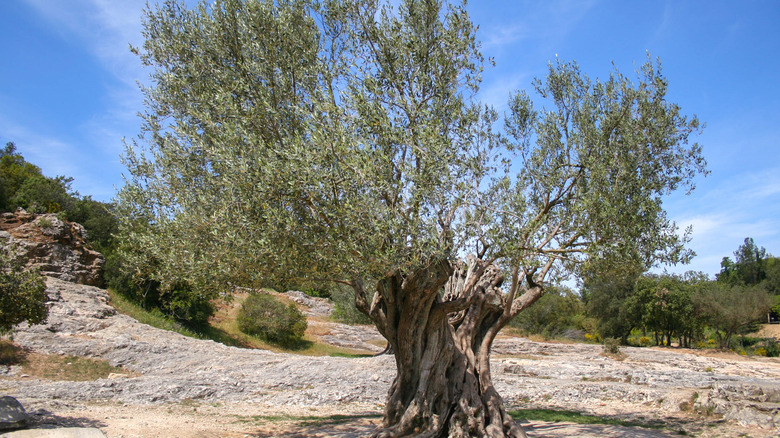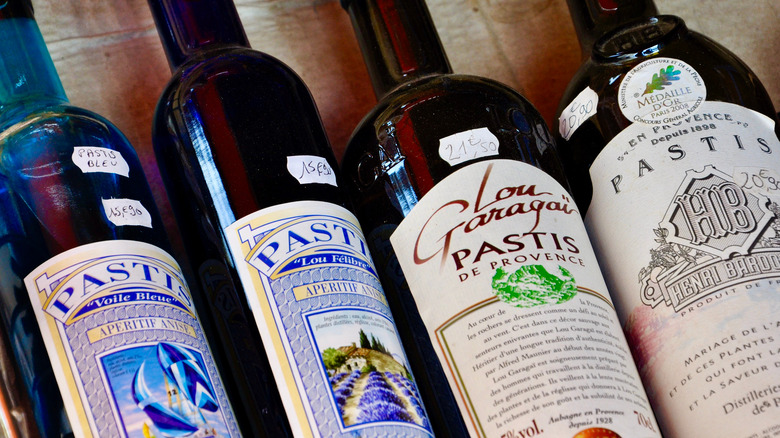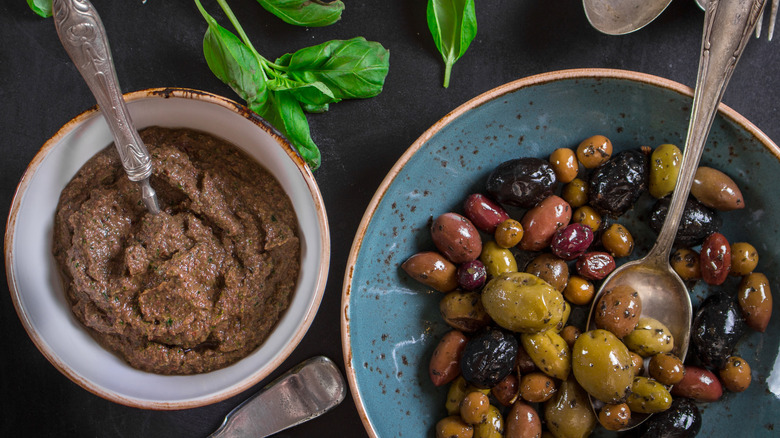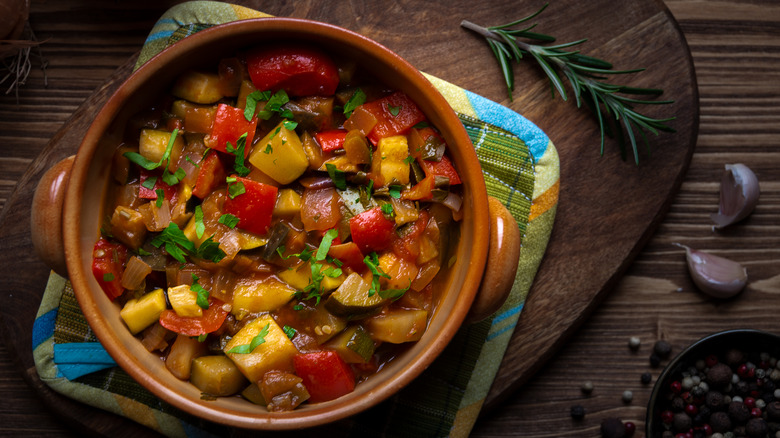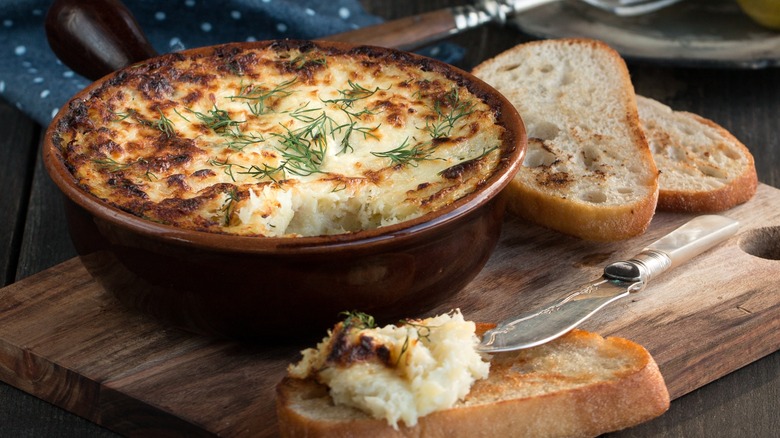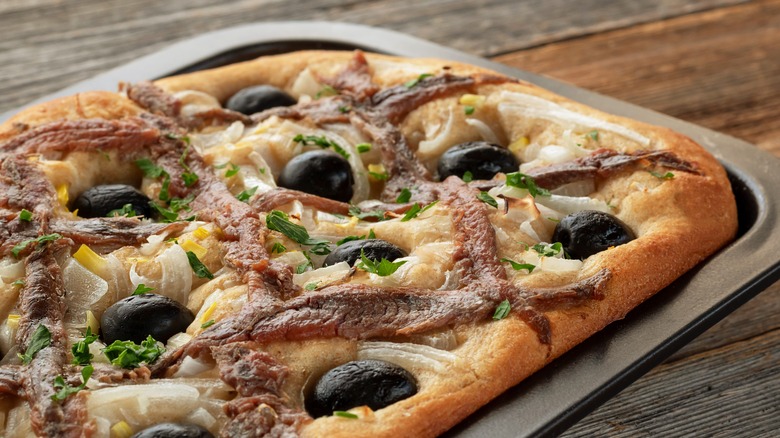13 Foods And Drinks You Have To Try In Provence, France
Meals in Provence never end with someone going hungry. This sunny and abundant part of France is known for a long growing season and plenty of coastline, ensuring a menu filled with fresh produce and seafood. Located in the southwestern part of the country, Provence is a diverse landscape that includes iconic scenes such as lavender fields and Mediterranean views, as well as the delights of tucked-away farms and restaurants serving up meals with generations of history.
And, of course, there is the wine. Provence is the global gold standard for rosé, and it's also a source of outstanding red and white wines as well as local spirits. Growing near the vineyards are ancient groves of olive trees, herbal vegetation, and seasonal gardens which provide the colorful array of fresh veggies and fruit that populate Provence's esteemed markets. The best advice is to come hungry because there are plenty of delicious things to eat and drink when visiting Provence.
Start with the benchmark for rosé wine
Rosé wine is gaining popularity, but it's not a fad. In fact, in Provence, pink wine has been a part of the culture dating back to antiquity since the Greeks planted vineyards around 2,600 years ago. Provence is even home to the world's only research center dedicated to rosé, Centre de Recherche et d'Expérimentation sur le Vin Rosé. According to Vins de Provence, an organization representing the region's wine producers, nine out of 10 French wine drinkers enjoy various types of rosé, and wine lovers everywhere seem to agree. Over 60 million bottles of rosé were exported from Provence in 2020, 40% of them sold in the U.S.
A visit to Provence allows travelers to taste bottles — many from small family producers using ecologically responsible techniques — that aren't imported to the United States. Explore different appellations, the largest of which is Côtes de Provence, with four terroir designations to enjoy. Parts of the South of France are culturally Provence but produce wines within the Rhône Valley realm (for instance, the well-known cru Châteauneuf-du-Pape). While this can be confusing at times, it's all part of learning about this fascinating region. With the careful production and terroir distinctions, rosé from Provence is endlessly interesting and pairs perfectly with the region's fresh veggies, seafood, and olive oil.
Don't miss out on Provence's red wine
Around 90% of Provence's wine production is dedicated to rosé, according to Vins de Provence. Rosés are largely made from red-skinned grapes pressed directly, allowing the juice a very short period of skin contact that results in the beautiful pink color for which it is famous. But some of these grapes are dedicated to producing various types of red wine — when allowed to spend more time in contact with the skins — crafting the flavor, color, and tannic profile of a classic vin rouge.
While this varies by appellation, the main red wine grapes in Provence are grenache noir, cinsault, syrah, mourvèdre, tibouren, and counoise — cabernet sauvignon, carignan, and others are also used. Many of the red wines from Provence are blends, though there is also the potential for single-varietal bottles. Thanks to the generous sun and a long growing season, Provençal red wines tend toward bold and full-bodied, though, of course, there is a range of possible presentations. These wines are lovely with fire-grilled food and matured cheeses.
Unexpected white wines from the South of France
Similarly, a small portion of wine crafted in Provence is white. Though this amounts to less than 5% of production, according to Vins de Provence, some say these wines are among the most impressive from the region. Particularly admired are some of the coastal, saline-tinged whites, such as those from Cassis, a fishing village located near the rocky cliffs and turquoise waters of Les Calanques, a protected natural park. White wines are produced in each appellation, with profiles ranging from floral to herbal to saline.
Varieties used to craft Provençal white wine include clairette, grenache blanc, sémillon, ugni blanc, rolle (also known as vermentino), bourboulenc, sauvignon blanc, and others. These wines go quite well with fried and fresh seafood, shellfish, salads, and plenty of classic dishes from Provence. White wines from Provence enjoy a high, if hard-to-find, reputation, and some expect to see this category grow, fulfilling the world's craving for mineral-driven and fresh wines to pair with food or enjoy as an apéro.
Put a little aïoli on it
The marriage of mainstay Provençal flavors, aïoli brings olive oil and garlic together in a mayonnaise-like condiment that far exceeds typical mayo expectations. Other ingredients include lemon, eggs, salt, and pepper, as in our garlic aïoli recipe. Once prepared, this is one of the most versatile flavors for almost anything from cooked or raw veggies, shrimp, French fries, potatoes, poultry — you-name-it — as long it goes with the creamy, garlicky profile of aïoli.
In Provence, it is often served with veggies, fish, or shrimp in the form of Le Grand Aioli or aioli monstre, a fresh and seasonal main course (think charcuterie board-style) that centers around this condiment. According to Perfectly Provence, this meal generally appears on restaurant menus on Fridays, following the religious tradition of abstaining from meat on that day. Radishes, endive, artichokes, boiled egg, baguette, green beans, new potatoes, and more are some of the classic partners for this fresh feast.
Sample bouillabaisse in Marseille
Bouillabaisse is a fish stew from Marseille, the second largest city in France, located in the Provence region on the Mediterranean coast. This place has witnessed the coming and going of people and goods since it was founded by the Greeks over 2,500 years ago (via Britannica). The Vieux-Port (Old Port) is the core of commerce and travel, and it's here that the fishmongers provide restaurants, markets, and locals with the freshest seafood of the hour.
Bouillabaisse recipes honor the seaside dining heritage of Marseille as a stew now served worldwide in local variations. It starts with a combination of white fish, langoustine, and mussels. Aromatic Provençal herbs and spices are traditional, and many cuisine-driven versions have a soup base made of carrots, fennel, saffron, tomatoes, celery, garlic, and onions. It can be served with broth separate from the prepared seafood and brought to the table in multiple dishes, or it can arrive as one piping-hot bowl of assembled stew. The original was based on bony fish that couldn't be sold to the market, so it was tossed together in a soup to feed anglers and their families. The local species that can be introduced are scorpionfish, spider, fielas, and capon, as well as monkfish, lobster, and galinette, according to Le Rhul Restaurant, an iconic Bouillabaisse restaurant in Marseille. To preserve the origins, local producers drew the Bouillabaisse Charter in the 1980s, led by Le Rhul Restaurant, which standardized the method of creation and service.
Eat like a farmer with Banon cheese
As it is with many culinary products in France, Banon cheese is named from where it originates, a small Provençal hill town called Banon, where indigenous goats once roamed. Banon cheese has its own protected appellation (AOC or appellation d'origine contrôlée) to preserve the heritage of this product, ensuring that consumers get authentic cheese made at its source and with appropriate gastronomic know-how (via AOC Banon). This includes 179 towns in four departments surrounding Banon: Alpes-de-Haute-Provence, Hautes-Alpes, Vaucluse, and Drôme.
The tradition behind this cheese is tied to the farmers who tended the herds on the grasslands of Banon and wrapped and preserved this cheese to eat throughout the year, not only when the milk was fresh. This cheese is also regarded as Banon à la feuille, which means Banon in a leaf, as it is traditionally wrapped in chestnut leaves and tied up with a strand of raffia. Inside is a circular, unpasteurized, sweet curd goat's milk cheese encased in a semi-bloomy rind. It's soft, creamy, and pungent in flavor.
Enjoy nougat, a sweet treat from Côte d'Azur
Many Americans know nougat as the textured and sweet hidden core of a candy bar such as Three Musketeers, but nougat from Provence is a complete reframe. It is a confection made with whipped egg, sweetened with honey or sugar, and enhanced with chopped nuts (often almonds) or dried fruit (via Provence Holidays). This can be produced in white or black form, depending on how it is cooked. The Provençal version of nougat is served during the Christmas tradition of Le Gros Souper, during which 13 dessert items are presented as part of an evening-long meal (via USA Today).
There is even a nougat museum in Montélimar, situated in the historical production facility of Arnaud Soubeyran. The shop offers classic products such as white and black nougat with local lavender honey and almonds. Special holiday nougat also features almonds, pistachios, candied oranges, and honey.
Find your favorite Provençal olive oil
The Mediterranean region has been associated with olive production for thousands of years, and widespread cultivation was championed by the Romans during the colonization of Provence and the surrounding regions. Not only are olives used for culinary purposes, but the oil is also a mandatory ingredient in the world-famous Savon de Marseille, a pure soap that is produced and sold with strict ties to its heritage (via Union des Professionnels du Savon de Marseille).
But for many, the ancient olive groves of Provence symbolize one thing: olive oil. According to the French Tourist Board in the US, olive oil is the "star of Southern French gastronomy," and, like wine, cheese, and other culinary products, some of it comes with origin designations signaling the uniqueness of where it is grown and how it is produced. In Provence, there are three AOCs (appellation d'origine contrôlée) and two AOPs (appellation d'origine protégée) — this means that olive oil produced within these zones can bear the name of where it came from, such as Des Baux de Provence, for example. Accordingly, the olive oils of these regions have distinct aromas and expressions of flavor, ranging from vegetal to fruity — each distinct in its own way.
Drink a Pastis in the afternoon
In Provence, pastis is an aperitif you must try, as much an experience as it is a pre-food beverage. It's an aniseed-flavored drink with around 40 to 45% alcohol, served with a measure of cool water or ice. In the glass, pastis blends with water, becoming an iconic pale yellow color and highly aromatic. Typically, pastis is associated with relaxed afternoons in the shade, perhaps after a game of pétanque, a Provençal boules sport. But the origins come from less soothing roots.
When the phylloxera blight destroyed French vineyards in the mid-1800s, wine supply was much less than demand. People turned to absinthe (myths of hallucinations) notwithstanding, an anise and wormwood-infused liqueur that is steeped in alcohol and often held responsible for bad behavior. It was eventually banned, along with other highly alcoholic drinks. Sensing an opening in the market, Paul Ricard from Marseille created an alternative. His botanical liqueur was lower in alcohol but still offered the unmistakable anise and licorice flavor profile (via Taste France Magazine). Though artisanal production is on the rise, Ricard still dominates the pastis scene, along with Pernod, both made by the same company, Pernod Ricard.
Discover a traditional dip
One of the best experiences in Provence is to have a picnic with a fresh, crusty baguette from the market and a few tasty accouterments to spread on each slice. Two of the best "dips" for bread are olive tapenade and a French anchovy dip called anchoïade. Both are savory and pungent and feature garlic, olive oil, and seasonings. Not only are they tasty as a canapé, but they can also be served alongside vegetable or fish dishes to lend a distinctly Mediterranean flair.
Basic tapenade recipes consist of olives blended together with the other flavors until the desired consistency. Similarly, anchoïade is packed with similar amounts of umami with regards to tinned anchovies, which are chopped and mixed with the associated ingredients. Both spreads are salty, satisfying, and incredibly easy to make. These are ideal apéro snacks and pair well with local wines, especially a chilled glass of rosé when served with crisp veggies and, of course, fresh-from-the-boulangerie bread.
Get your veggies in a big bowl of ratatouille
Ratatouille is one of the most satisfying and savory vegetable dishes from Provence. Traditional French ratatouille recipes are easily imagined as a farmer or gardener meal, centered as the dish is on home-grown veggies. Ratatouille is a hearty pot of produce crafted with aromatic herbs and garlic. Prepared in sturdy earthenware, the plate includes chopped tomatoes, eggplant, zucchini, peppers, and onions seasoned with herbs such as parsley and thyme and simmered for up to a couple of hours.
When it's time to eat, ratatouille can be served as the main course or alongside fish and meat dishes. During Provence's windy winter, a piping hot bowl of ratatouille is warming and fragrant. In the sunny summer months, it can be served chilled with a sprinkle of refreshing tender herbs for a cooling lunch or dinner. When arranged in a spiral and covered with cheese and/or breadcrumbs, this dish is fashioned as a tian.
Be comforted by brandade de morue
In maritime communities around the world, cod is a cuisine staple. To preserve the fillets of this fish, many cultures cure it with a significant amount of salt, which must be removed before preparing. A reason preserved fish were more common than fresh ones was that the conservation technique was once essential to maintain the quality of the fish until it could be transported or sold at the market. This has historically been a common practice in the fishing towns along the Mediterranean coast, including spots in Provence and nearby Languedoc.
The star of brandade de morue is none other than salt cod, a highly aromatic meal that is regarded as one of the most comforting dishes of Provence. According to Regions of France, the earliest versions of the dish brandade de morue included garlic and milk. Modern takes have added potato puree — all whipped together like a mousse, baked as a gratin, covered with grated and salty cheese, and baked until it's browned.
Savor pissaladière, a salty street snack
Nice is an ancient town in coastal Eastern Provence, the capital of the French Riviera. It has one of the most vibrant street scenes in the region, with old-town charm plus plenty of ritzy opulence and beach vibes. It's the kind of place where people like to be out, strolling and socializing. For hungry people that don't want to sit inside for a full meal, a hand-held slice of pissaladière onion tart is the answer.
This savory and salty tart has a bready crust similar to focaccia and is topped with caramelized onions, olives, anchovies, and herbs. According to Lou Messugo, look for pissaladière at "boulangeries and snack bars all over the Côte d'Azur." It can be eaten by the slice and enjoyed picnic style, served hot or at room temperature. Some say that it is reminiscent of pizza, but there is no sauce or cheese on pissaladière, making a unique dish central to Nice and coastal Provence.
